Upland Game Birds of the Longleaf Forest
Steeped in great southern tradition, much of the longleaf landscape was historically managed for recreational hunting for Northern Bobwhite, Eastern Wild Turkey, and American Woodcock. A mosaic of vegetation for cover and nesting, and open space for young birds to navigate through the forest floor, is key for these species.
Northern Bobwhite (Colinus virginianus)
 Northern Bobwhite QuailDick Daniels
Northern Bobwhite QuailDick DanielsNorthern Bobwhite inhabit mature open pine and early successional habitats that have well developed and diverse herbaceous ground cover. These suitable herbaceous cover conditions occur from frequent disturbance (burning, disking, roller chopping, etc.), within open pine forest/woodland, immediately after tree harvest, and in association with fields in agricultural habitats. Historically, fire and tree mortality resulted in millions of acres of high-quality bobwhite habitat across the southeastern United States, including the longleaf and shortleaf forests of the West Gulf Coastal Plain/Ouachitas region. However, conversion of native forests to other land use, including altered silviculture, and associated reduction in early succession habitat has greatly reduced the areas of suitable habitat for bobwhite.
Management for Northern Bobwhite in open pine habitat should: (1) allow sunlight to reach the forest floor, and (2) provide ground vegetative structure that affords mobility, nesting cover, and forage opportunities (e.g., insects, legumes, and soft mast). Pine canopy cover ranging from 40% to 60% or basal area between 20 and 70 feet per acre are considered optimal in southern pine forests, with the understory and mid-story frequently disturbed (preferably with frequent fires) to set back plant succession and maintain grass and forb diversity. Where prescribed burning is not feasible, other means of setting back succession, such as fallow disking and roller chopping, may be effective.
Eastern Wild Turkey (Meleagris gallopavo)
 Eastern Wild TurkeyNational Wild Turkey Foundation
Eastern Wild TurkeyNational Wild Turkey FoundationFrequent fire in longleaf pine ecosystems improves forest conditions for many wildlife species, including Eastern Wild Turkey. Without management, a forest understory can become choked with brush, limiting a wild turkey’s ability to avoid predators. However, a forest with an open understory provides usable space for these game birds. Longleaf pine can be managed in a way that allows for sunlight to reach the forest floor, increasing biodiversity and encouraging an herbaceous understory. Habitat quality is increased when prescribed fire is used as a management tool, and the herbaceous growth following a fire provides excellent foraging, nesting, and brooding habitat for wild turkeys. Bottomland hardwood habitat that may be interconnected with longleaf pine habitat is also crucial to the wild turkey. Bottomland hardwood forests are naturally disturbed by periodic flooding, which creates usable space and increases habitat quality. Since these bottomlands serve as travel corridors for wild turkeys and may provide hard and soft mast, conserving both the longleaf pine and bottomland habitats is vital.
American Woodcock (Scolopax minor)
 American WoodcockJohn Turner, courtesy of American Bird Conservancy
American WoodcockJohn Turner, courtesy of American Bird ConservancyThe American Woodcock (Scolopax minor) is a popular migratory game bird that can be found in longleaf pine stands during the 45-day hunting season in East Texas (typically December 18-January 31 each year). Recently burned (within the past 2 years) longleaf pine stands on sandy loam soils are usually good places to find these birds. They are known to prefer areas with an interspersion of woody shrubs such as Waxmyrtle and bare soils. As one ole’ timer once said, “...they like to have something green over their heads.”
Woodcock are more active in the mornings and evenings but can be found throughout the day in clumps of suitable habitat. Markers of suitable habitat include probe holes (where they’ve poked their bills in the soil to find earthworms) and splat (where they’ve defecated) on moist sandy loam soils with clumps of thick vegetation. Longleaf pine stands usually provide the requisite suitable habitat for these winter migrant/spring breeders. Longleaf pine in the grass stage provides especially good areas for courtship and breeding as well.
Well-managed longleaf pine that is frequently burned provides for the needs of this species. Available information suggests American Woodcock populations have been on the decline for over 50 years due to the loss and degradation of early successional forest habitat.
Longleaf pine restoration creates early successional habitat, and, more often than not, longleaf soils are suitable for woodcock to find shelter and food. Management through prescribed burning to enhance understory grasses and herbaceous vegetation, while also controlling woody vegetation and volunteer loblolly pine, usually makes for good hunting grounds!
For more information about the American woodcock, visit the Ruffed Grouse Society & American Woodcock Society.
